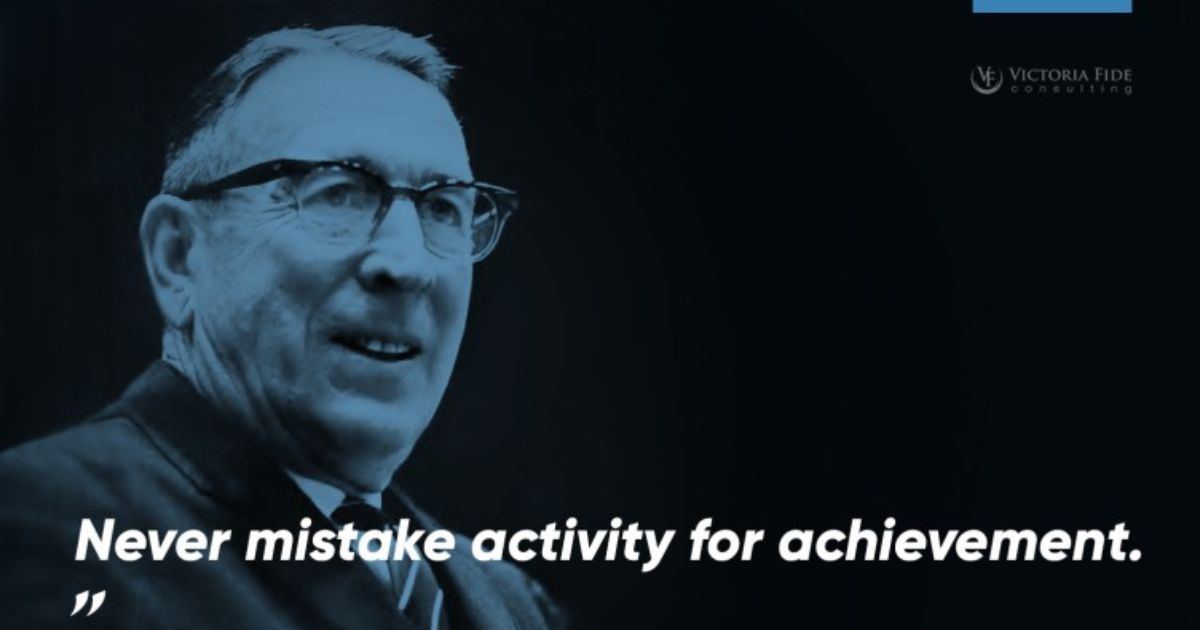
The Sage Wisdom series is produced by Victoria Fide Marketing with input and oversight from our leadership team and industry SMEs.
John Wooden (1910-2010) was an American basketball player and coach, best known for his incredible success as the head coach of the UCLA Bruins men’s basketball team. He is widely regarded as one of the greatest basketball coaches in history and his coaching philosophy and leadership principles have had a lasting impact on the world of sports and beyond.
His quote “Never mistake activity for achievement” reflects Wooden’s belief that simply being busy or engaged in various tasks does not necessarily lead to meaningful accomplishments. Instead, true achievement comes from purposeful actions that align with well-defined goals and values.
This quote serves as a warning for organizations facing project failure due to a phenomenon called project thrashing. This article dives into how project thrashing surfaces in implementations and provides three strategies for avoiding this paralyzing phenomenon in your digital transformation.
The 4 Warning Signs of Project Thrashing
Project thrashing refers to a state in which a project becomes trapped in a cycle of excessive, unproductive activity that hinders progress and impedes successful completion. It’s a scenario where energy and effort are expended, yet meaningful advancement is stymied. This phenomenon often arises when organizations are unable to maintain focus, direction, or a clear path toward their objectives.
In the realm of project thrashing, various scenarios unfold that lead to unproductive cycles and hinder the advancement of implementations.
Last-Minute Requirement Changes
One common way that project thrashing manifests is through last-minute requirement changes. These abrupt alterations can disrupt established plans and force teams into a reactive mode, diverting attention from the core project goals. Such changes often stem from a lack of upfront clarity or effective communication, leading to a cycle of adjustments that hinder progress.
Never-Ending Backlog
The presence of a never-ending backlog is another sign of project thrashing. When new tasks are continuously added without a corresponding completion rate, the backlog grows unchecked. This can overwhelm teams and create an illusion of constant activity, even as essential objectives remain unachieved. Without proper prioritization and resolution, this cycle perpetuates stagnation.
Static Percent Complete
A project caught in thrashing may exhibit a misleading sense of progress, where the percentage complete remains static despite ongoing efforts. This occurs when tasks are started but not successfully concluded, leaving the project’s overall status unchanged. Such scenarios often indicate an inability to bring tasks to closure, leading to a cycle of repetitive work that fails to contribute to meaningful outcomes.
Revisiting Previous Decisions
In instances of project thrashing, teams might frequently revisit decisions that were previously considered finalized. This can arise from indecisiveness, evolving stakeholder preferences, or an inability to commit to a chosen course of action. The result is a looping cycle of uncertainty, eroding the project’s momentum and consuming resources without achieving substantive results.

Free PDF Download
In the rapidly changing digital landscape, more and more companies are desperately trying to keep up with the competition. Download “The 10 Biggest Mistakes Businesses Make in Digital Transformation” for free today to learn how to use DX to radically transform your business and gain an edge over your competitors.
3 Ways to Avoid Project Thrashing
To safeguard against project thrashing and ensure successful digital transformation, a comprehensive approach is essential. Begin with meticulous planning and scope definition, reinforce progress with strong change management and communication, and employ an agile implementation strategy to adapt and evolve while maintaining project integrity.
1. Comprehensive Planning and Scope Definition
To steer clear of project thrashing, start with careful planning and clearly defining the scope of your project. This means laying out exactly what needs to be done, setting clear goals, and understanding the steps required to reach them.
2. Strong Change Management and Communication
Avoid the trap of project thrashing by embracing strong change management and effective communication. Ensure that everyone involved understands the project’s purpose, the changes it brings, and why those changes matter. Keep the lines of communication open so that everyone is on the same page.
3. Agile Implementation Approach
Choosing an agile implementation approach can be a game-changer in preventing project thrashing. With an agile mindset, you break your project into smaller, manageable pieces. This way, you can adapt and make changes as needed without derailing the entire project.
Ready to Rescue Your Implementation? Get Expert Advice
Don’t fall into the trap of mistaking activity for achievement—staying busy doesn’t always mean you’re making progress. By following these three proactive strategies, you can steer clear of project thrashing and guide your digital transformation journey to success. For more insights on rescuing challenging ERP implementations, head over to our blog post: “How to Rescue a Troubled ERP Implementation in 5 Steps” by founder and CEO of Victoria Fide Consulting, Tory Bjorklund. If you’re currently in the middle of an implementation suffering from project thrashing, schedule a free 30-minute consultation to help you get your project back on track.
Subscribe to our weekly LinkedIn Digital Transformation Success newsletter and get notified of each new edition.

